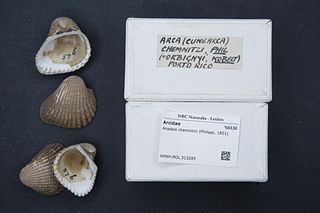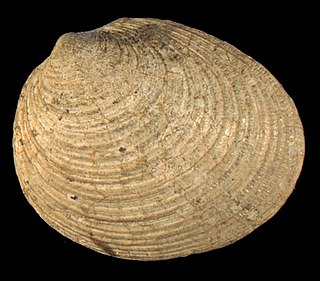
Arca imbricata, or the mossy ark clam, is a clam in the family Arcidae. It can be found along the Atlantic coast of North America, ranging from North Carolina to the West Indies, Brazil, and Bermuda.

Anadara brasiliana, common name the incongruous ark clam, is a saltwater clam in the family Arcidae, the ark shells. This species is found along the Atlantic coast of North America, from North Carolina to Brazil.

Anadara chemnitzii, common name Chemnitz's ark clam, is a saltwater clam in the family Arcidae, the ark shells. This species is found in the Caribbean Sea, from Texas to the West Indies and Brazil.

Anadara transversa, or the transverse ark clam, is a clam in the family Arcidae. It can be found along the Atlantic coast of North America, ranging from Massachusetts to Texas, including the West Indies.

Limopsis sulcata, common name the sulcate limopsis, is a species of very small clam, a marine bivalve mollusk in the family Limopsidae. This species occurs along the Atlantic coast of North America from Massachusetts to the West Indies.

Lima lima, or the spiny fileclam, is a species of bivalve mollusc in the family Limidae.

Eucrassatella speciosa, or Gibbs' clam, is a species of bivalve mollusc in the family Crassatellidae. It can be found along the Atlantic coast of North America, ranging from North Carolina to the West Indies.
Chama congregata, or the corrugated jewel box clam, is a species of bivalve mollusc in the family Chamidae. It can be found along the Atlantic coast of North America, ranging from North Carolina to the West Indies and Bermuda.

Chama macerophylla, or the leafy jewel box clam, is a species of bivalve mollusc in the family Chamidae. It can be found along the Atlantic coast of North America, ranging from North Carolina to the West Indies.
Pseudochama cristella, or the left-handed jewel box clam, is a species of bivalve mollusc in the family Chamidae. It can be found along the Atlantic coast of North America, ranging from southern Florida to the West Indies.

Arcinella arcinella, or the Caribbean spiny jewel box clam, is a species of bivalve mollusc in the family Chamidae.
Americardia is a genus of saltwater clams, marine bivalve molluscs in the family Cardiidae, the cockles.
Americardia media, the Atlantic strawberry cockle, is a species of saltwater clam, a marine bivalve mollusc in the family Cardiidae, the cockles. This species can be found along the Atlantic coast of North America, from Cape Hatteras to the West Indies.

Periglypta listeri, or the princess Venus clam, is a species of bivalve mollusc in the family Veneridae. It can be found along the Atlantic coast of North America, ranging from southern Florida to the West Indies.
Ventricolaria rigida, or the rigid Venus clam, is a species of bivalve mollusc in the family Veneridae. It can be found along the Atlantic coast of North America, ranging from southern Florida to the West Indies and Brazil.
Pitar circinatus, common name the "purple venus clam", is a species of bivalve mollusc in the family Veneridae, the venus clams. This species can be found around the coasts of the islands in the West Indies.
Macrocallista is a genus of saltwater clams, marine bivalve mollusks in the family Veneridae, the Venus clams.

Macrocallista maculata, or the calico clam, is a species of bivalve mollusc in the family Veneridae. It can be found along the Atlantic coast of North America, ranging from North Carolina to Bermuda and Brazil.
Dosinia concentrica, common name the West Indian dosinia, is a species of saltwater clam, a marine bivalve mollusc in the family Veneridae. This species is found in Caribbean waters, ranging from the West Indies to Brazil.
Parastarte triquetra, or the brown gem clam, is a species of bivalve mollusc in the family Veneridae. It can be found along the Atlantic coast of North America, ranging from Florida to the West Indies.











